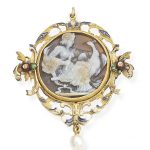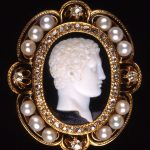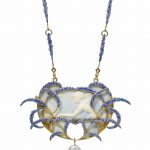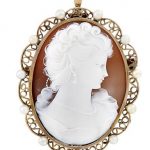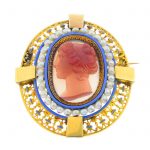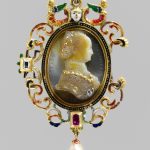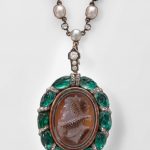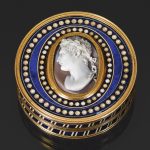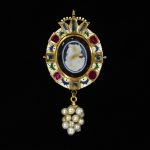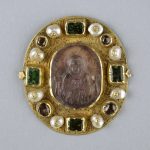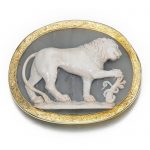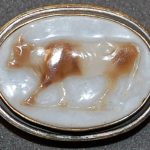Pearls have often been used to enhance cameo jewellery and other items. For thousands of years, seawater pearls were retrieved by divers in the Indian Ocean in areas such as the Persian Gulf, the Red Sea and the Gulf of Mannar. Evidence also suggest a prehistoric origin to pearl diving in these regions. Starting in the Han Dynasty (206 BC–220 AD), the Chinese hunted extensively for seawater pearls in the South China Sea. In the 14th-century Arabian Sea, the traveller Ibn Battuta provided the earliest known description of pearl diving by means of attaching a cord to the diver’s waist. Reference: Wikipedia
Below are some examples of pearls used with cameos.
A Neo-Renaissance gold, enamel, hardstone cameo and pearl pendant, 19th century The circular hardstone cameo, carved in low relief to depict the Goddess Juno seated in a chair, with one arm around a peacock, possibly 16th-17th century, within a scrolling gold frame with floral and foliate motifs, decorated in polychrome enamel, suspending a 7.0mm x 6.2mm pearl drop, pearl untested, some enamel loss, length 6.5cm
Sold for £5,625 inc. premium at Bonhams in
Pendant inset with cameo; onyx; head of Hercules; enamelled gold pendant setting with diamonds and pearls. Made by: Giuseppe Girometti (cameo)
Reference: © The Trustees of the British Museum
AN ART NOUVEAU GALALITH, ENAMEL AND PEARL PENDENT NECKLACE, BY RENÉ LALIQUE The galalith cameo pendant figuring the profile of a nymph, set within a spray of lavender flowers, suspending a baroque pearl, to the similarly-set chain, circa 1905, pendant 9.5 cm, chain 66.0 cm, with French assay marks for gold Signed Lalique Please note that the pearl has not been tested for natural origin.
Sold for CHF 348,500 at Christies in 2017
Gold, Pearl and Shell Cameo Pendant-Brooch 14 kt., 11 pearls ap. 3.7 to 3.5 mm., ap. 11.3 dwts. Pearls have not been tested.
Pearls: round, off white color, good to very good luster Overall in good condition, normal wear withminor discoloration to metal. Measuring ap. 2 1/4 x 1 7/8 inches
Sold for $292 (includes buyer’s premium) at Doyle New York in 2018
An early Victorian gold cameo brooch. Of openwork design, the agate cameo, carved to depict a lady in profile, with blue enamel and seed pearl surrounds and quatrefoil bar accents. Length 5cms. Weight 20gms. CONDITION Overall condition good. Surface scratches and slight discolouration in keeping with general age and wear. Agate is speckled red and semi-translucent off-white. Agate is in good condition. Seed pearls untested for natural origin. Seed pearls are a creamy white hue with greenish overtones. Seed pearls are in good condition with minor nacre loss. Blue enamel is in good condition with a few areas of minor loss.
Sold for £960 at Fellows in 2018
Bona Sforza (1493–1557), Queen of Poland. Cameo by Giovanni Jacopo Caraglio (Italian, Parma or Verona ca. 1500/1505–1565 Krakow (?)) frame 19th century
Exceptionally for the Renaissance, this is a signed cameo, bearing the signature of Gian Giacomo Caraglio, who was born in Verona and later worked in Venice and then Cracow and who was best known as a printmaker. Bona Sforza, daughter of the duke of Milan, married Sigismund I, king of Poland, in 1518. At Sigismund’s death in 1548 she returned to Italy, where she died in 1557. The cameo is inlaid with gold that enhances details of Bona’s chain and hairnet, and a silver Medusa’s head (see detail; for Medusa, see also fig. 59) is inset on her breast, in the same spirit of jewelry within jewelry. The only other gem signed by Caraglio, an agate similarly bedecked with gold representing Barbara Radziwill, Bona’s successor as queen of Poland, is in the Münzkabinett, Munich. The dainty frame, although dated 1554 on the reverse, is a nineteenth-century invention.
Reference: The Metropolitan Museum of Art
Necklace with a cameo of Elizabeth I English about 1890
The pendant brooch hangs on a choker-length chain composed of bezel-set pearls, graduated in size, which alternate with silver-on-gold closed-prong settings of old mine-cut diamonds. These elements are connected by gold links. The necklace terminates in a gold rectangular box clasp; two rows of five tiny rose-cut diamonds are set on the top surface. The bail which attaches the pendant to the chain consists of three silver-on-gold prong-set rose-cut diamonds arranged vertically. The top diamond is larger than the two below. On the reverse is a hook which permits the pendant to detach from the chain allowing it to be worn on a longer chain.
The pendant consists of a centrally set oval agate, carved by George Bissinger with a profile image of Elizabeth I. The mount of the cameo, designed by Mrs. Philip (Charlotte) Newman, is composed of a laurel wreath border of leaf-carved emeralds each separated by rows of rose-cut diamonds, except at the top and bottom where the emeralds are divided by double rows.
Reference: Museum of Fine Arts Boston
A gold-mounted pietra dura and cameo Imperial portrait snuff box, Galleria dei Lavori, Florence, circa 1805-1810 circular, the lid inset with a fine agate cameo of Napoléon I, in profile to dexter, after the Antique, wearing a laurel wreath, by Nicolo Morelli, signed: MORELLI under the truncation, gold frame, the ground of lid and base of lapis lazuli divided by slender gold and white chalcedony fillets within strings of hardstone simulated pearls, the sides diagonally striped in gold, lapis and white chalcedony, gold lining and gadrooned gold mounts and rims, apparently unmarked
Sold for 75,000 GBP at Sothebys in 2018
Pendant of enamelled gold set with an onyx cameo of Queen Elizabeth I and with table-cut rubies and diamonds; hung with a cluster of pearls. An oak tree is enamelled on the back plate.
According to a family tradition, this jewel was made for William Barbor (died 1586). He was a Protestant.The tradition, apparently first recorded in 1724, says that he wanted to commemorate his escape from the stake thanks to the accession of Elizabeth I (1558-1603). However, the style of the enamelling provides a date for the setting of about 1615-1625. The tradition that this jewel was commissioned by William Barbor (1540-86) to commemorate his escape from being burnt at the stake as a heretic during the reign of Queen Mary was recorded by Gabriel Barbor in 1724. William Barbor may have owned the cameo of Elizabeth I, but the current setting dates from about 1615-25, suggesting that William’s family regarded the essential element in the jewel as the cameo, while the setting was changed to keep the jewel in fashion. Gabriel Barbor believed that William had laid down that the jewel was to descend to his eldest son, but only if he had a daughter and named her Elizabeth: ‘this is the account as it has been handed down from father to son, and hitherto there has always been an Elizabeth in the family’. The will of John Barbor in 1757 stated that the jewel should pass to his brother John, but, if he had no children, to his brother Richard. Richard’s daughter, Elizabeth, who had married Henry Prescott Blencowe in 1774 (information kindly provided by Sarah Jane Barber), inherited the jewel on her father’s death.
Reference: © Victoria and Albert Museum
Cover of Reliquary Pendant with Virgin and Child
This exceptional pendant consists of a reliquary cross inside a hinged case with six small adjacent compartments for relics (see also Walters 57.1511B and 57.1511C). The impressive amethyst cameo depicting the Virgin and Child on the lid is surrounded by cabochon rubies and emeralds alternating with pearls. The cross and the outer edge of the case are adorned with additional pearls, and the back of the case is decorated in a similar fashion, omitting the central cameo. A ground of dense filigree covers the front and back of the case, while the inside as well as the inscription and the Crucifixion scene on the cross are done in niello. The text identifies the donor, location, and the time when the piece was crafted, which is rare in Post-Byzantine jewelry: the cross was dedicated by the Metropolitan Arsenios of Serres, a town in northern Greece, to the monastery of St. John on the island of Chalke near Constantinople in the middle of the 16th century.
Reference: The Walter Art Museum
